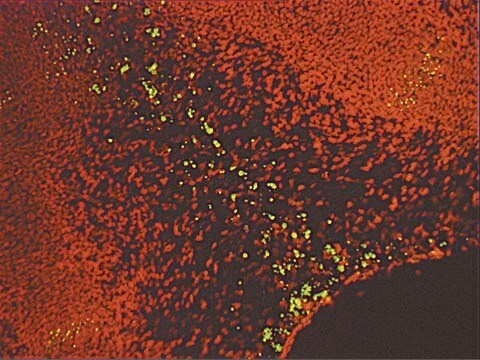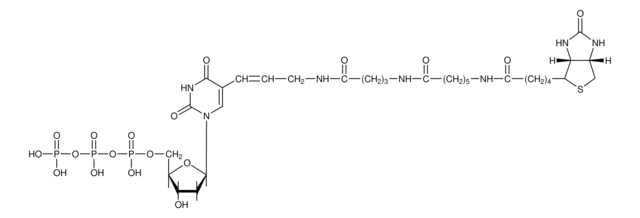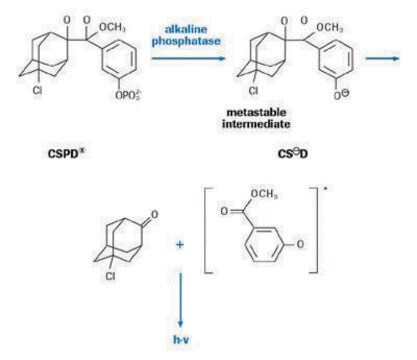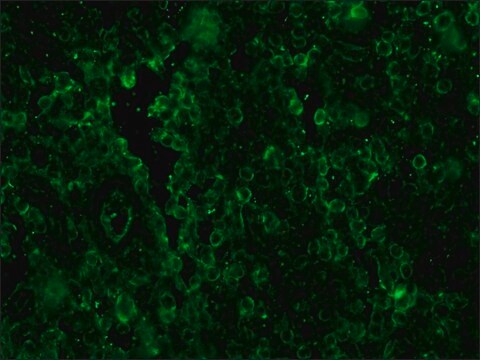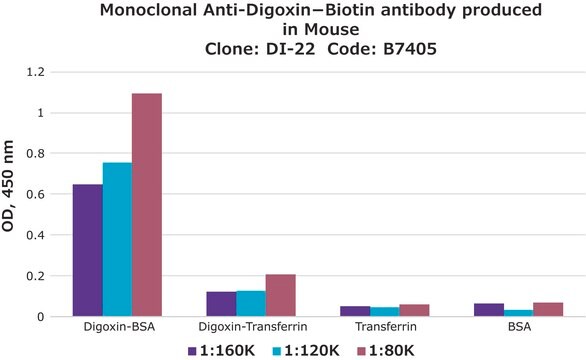Kluczowe dokumenty
11207741910
Roche
Anti-Digoxigenin-Fluorescein, Fab fragments
from sheep
Synonim(y):
anti-digoxigenin, digoxigenin
About This Item
Polecane produkty
pochodzenie biologiczne
sheep
Poziom jakości
białko sprzężone
fluorescein conjugate
forma przeciwciała
purified immunoglobulin
rodzaj przeciwciała
primary antibodies
klon
polyclonal
Postać
lyophilized
opakowanie
pkg of 200 μg
producent / nazwa handlowa
Roche
izotyp
IgG
temp. przechowywania
2-8°C
Opis ogólny
Specyficzność
Zastosowanie
- Digoxigenin-labeled sugars in glycoconjugate research
- Fluorescent in situ hybridization (FISH)
- Immunohistocytochemistry
- In situ hybridization
Uwaga dotycząca przygotowania
- Working concentration: Working concentration of conjugate depends on application and substrate. The following concentrations should be taken as a guideline:Detection of digoxigenin-labeled sugars in glycoproteins: 50 to 20μg/ml
- Fluorescent in situ hybridization (FISH): 1 to 20μg/ml
- Immunohistocytochemistry: 20 to 50μg/ml
- In situ hybridization: 20 to 50μg/ml
The anti-DIG anitbody is highly specific and sensitive. Therefore, for FISH, a concentration of 1μg/ml is sufficient, and only in case of critical probes, this concentration may be raised to <10μg/ml (with a distinct background to be expected).
Working solution: Reconstitution
Add 1 ml double-distilled water to a final concentration of 200μg/ml.
Blocking:
PBS, 0.5% bovine serum albumin (w/v), pH 7.4.
1% Blocking reagent (w/v), 1 to 5% heat inactivated fetal calf serum (v/v) or sheep normal serum can be used for reduction of unspecific binding. Furthermore, pH can be increased up to pH 8.5 to 9.0.
Storage conditions (working solution): Always prepare fresh!
Rekonstytucja
Inne uwagi
Nie możesz znaleźć właściwego produktu?
Wypróbuj nasz Narzędzie selektora produktów.
Hasło ostrzegawcze
Warning
Zwroty wskazujące rodzaj zagrożenia
Zwroty wskazujące środki ostrożności
Klasyfikacja zagrożeń
Aquatic Chronic 3 - Skin Sens. 1
Kod klasy składowania
13 - Non Combustible Solids
Klasa zagrożenia wodnego (WGK)
WGK 2
Temperatura zapłonu (°F)
does not flash
Temperatura zapłonu (°C)
does not flash
Certyfikaty analizy (CoA)
Poszukaj Certyfikaty analizy (CoA), wpisując numer partii/serii produktów. Numery serii i partii można znaleźć na etykiecie produktu po słowach „seria” lub „partia”.
Masz już ten produkt?
Dokumenty związane z niedawno zakupionymi produktami zostały zamieszczone w Bibliotece dokumentów.
Klienci oglądali również te produkty
Produkty
Digoxigenin (DIG) labeling methods and kits for DNA and RNA DIG probes, random primed DNA labeling, nick translation labeling, 5’ and 3’ oligonucleotide end-labeling.
Metody znakowania digoksygeniną (DIG) i zestawy do sond DNA i RNA DIG, znakowanie DNA z losowym primerem, znakowanie nickiem translacyjnym, znakowanie końcowe oligonukleotydów 5' i 3'.
Nasz zespół naukowców ma doświadczenie we wszystkich obszarach badań, w tym w naukach przyrodniczych, materiałoznawstwie, syntezie chemicznej, chromatografii, analityce i wielu innych dziedzinach.
Skontaktuj się z zespołem ds. pomocy technicznej


